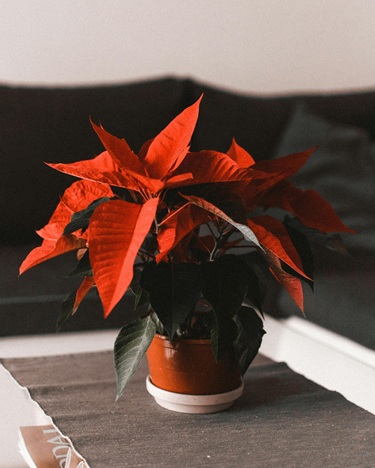
Christmas, as we all know, is a winter holiday. Yet in spite of its season, it has a surprising amount of plant life associated with it. Christmas trees make sense—after all, pine trees retain their needles throughout the winter. European mistletoe also blooms in winter, which led to it being featured in Christmas pageantry. In reality, mistletoe is a hemi-parasitic plant. It can photosynthesize, but it prefers to latch on to tree branches and steal water and nutrients from a tree. Not the best example of the Christmas spirit.
This article will focus on a lesser known, yet still popular, plant associated with Christmas: the poinsettia. Unlike Christmas trees and mistletoe, many families wish to keep these poinsettias around past Christmas but are frustrated when they end up dying. Let’s figure out how to keep these guys alive until the next holiday season, shall we?
If you’re looking for a simple answer as to why your poinsettias are dying, overwatering is the main culprit. Watering a poinsettia like you would a shrub or a flowerbed will kill them. You also need to understand that poinsettias are not going to stay red year-round. With that said, let’s take a closer look at the poinsettia.
Poinsettias
Poinsettias are found in Central America, covering swaths of Mexico and peeking into Guatemala. Wild poinsettias look much different than the cultivated breeds you can purchase at your local garden center or hardware store during the holidays, but they still keep the flower’s distinctive red coloring.
So, what do we do to keep a poinsettia alive and healthy for next Christmas? Truthfully, they are tricky plants to manage. There’s a reason why so many poinsettias are bought each winter. Even if you keep the plant alive for a year, there’s no guarantee that the poinsettia’s iconic red color will appear for the next Christmas. Still, it is possible to keep a poinsettia blooming for many consecutive Christmases. Let’s break things down step by step.
Once the New Year begins, fertilize your poinsettia to prolong its bloom. After this initial fertilization, reapply fertilizer every 4 weeks. You’ll also want to make sure you’re keeping an eye on potential pests. Whiteflies have a nasty habit of finding their way into poinsettia pots. While using a biological control method such as green lacewings is a great way to keep whiteflies under control, most poinsettias are kept indoors, making this method of pest control significantly less appealing. Instead, try an organic pest control method such as Agro Pest.
You should be watering your poinsettia rarely. To prevent overwatering, wait until the soil is dry, then wait a couple of extra days before watering. If you’re watering more than once a week, you are overwatering. Once March arrives, prune your poinsettia until it is no more than 8 inches tall to encourage new growth. You can move your poinsettia outside for the summer, but you’ll need to stop applying fertilizer in August to prepare the plant for its dormant period. Take your poinsettia back inside and into a controlled growing environment once September comes to an end.
Poinsettias are photoperiodic, meaning they need long nights to trigger blooming. This blooming is what causes the deep red color to emerge. Once you’ve moved your poinsettia back inside, it will need 14 hours of complete darkness each night for about 8-10 weeks. Do this by placing the plant in a dark closet or covering it with a box. Even brief exposure to light at this time will prevent a poinsettia from blooming for Christmas.
During the day, return the plant to bright, indirect light. Continue this routine until the bracts (the official name for the red-colored leaves) begin to show color, usually around early December. If everything has been done correctly, your bright red leaves will return as you’re putting the Christmas tree back up. If your leaves do not turn red, don’t feel too bad. Poinsettias are notoriously finicky, and you can always try again next year.
ARBICO Organics was founded in 1979 in Arizona. Over 40 years later, ARBICO Organics continues to produce innovative means of natural biological pest control and disease management for hobbyists and professionals alike.




Comment here